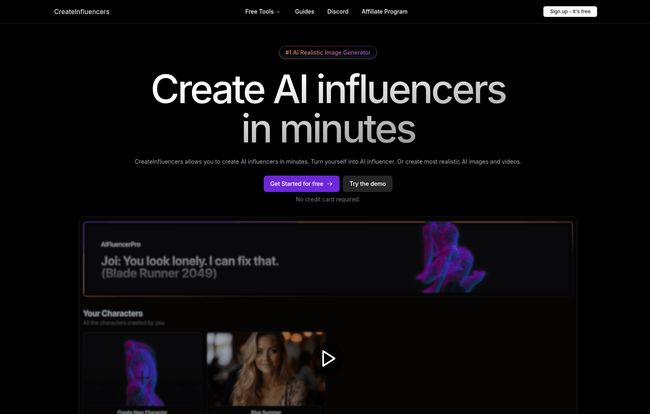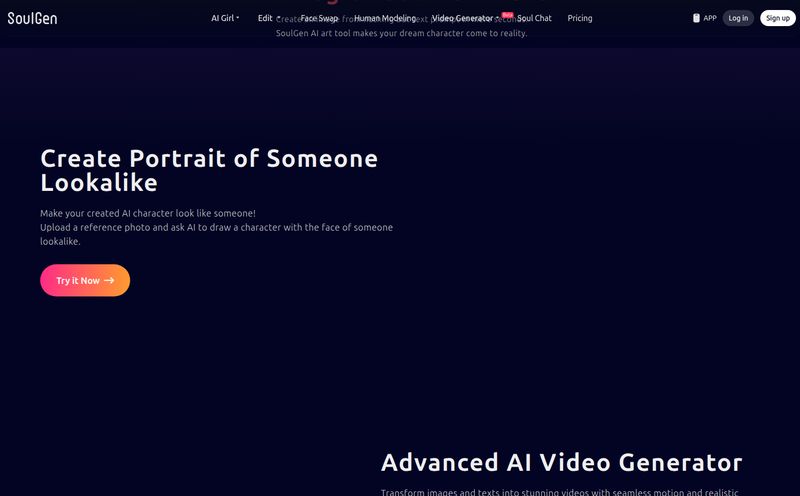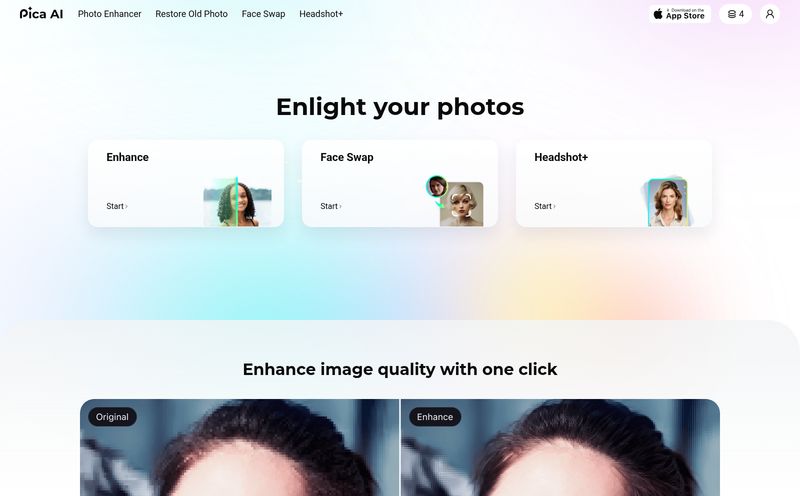For years, I’ve been neck-deep in the world of traffic generation, SEO, and the ever-shifting sands of social media. I’ve seen trends come and go. Remember when every brand suddenly needed a Snapchat filter? Good times. But the rise of virtual influencers… that’s a different beast entirely. We’ve all seen profiles like Lil Miquela and wondered, “How?” and more importantly, “Why?”
The “why” is simple: creating consistently stunning, on-brand content is hard. It’s expensive, time-consuming, and requires coordinating a whole circus of people. So, when a tool like CreateInfluencers.com lands on my radar, claiming you can create AI influencers in minutes, my professional curiosity goes into overdrive. Is it just another gimmick, or is this a genuine game-changer for marketers, creators, and maybe even the curious hobbyist? I had to find out.
I spent some time with the platform, burned through my free credits, and honestly, I have some thoughts. So grab a coffee, and let's get into it.

Visit CreateInfluencers
So, What is CreateInfluencers, Really?
At its core, CreateInfluencers is an AI-powered playground for generating digital humans. Think of it less like a simple photo editor and more like a high-tech digital puppet master's toolkit. The platform lets you do two main things: create a completely fictional AI influencer from scratch or, and this is the wild part, upload your own photos to turn yourself into an AI model.
It's not just about static headshots, either. The whole point is to generate a stream of content—realistic selfies, lifestyle shots, videos, and avatars for marketing campaigns. It’s designed to be a one-stop shop for anyone needing a human face for their brand or project, without needing an actual human.
Diving In: The Key Features That Caught My Eye
Signing up was painless, and they give you a handful of free credits to start, which I always appreciate. No credit card required to just poke around. The interface is clean, dark-themed, and pretty intuitive. But let's get to the good stuff—the tools.
Building Your Digital Persona
The first thing you’ll likely do is create a character. You can either generate one or upload about 10-20 of your own selfies to train a model of yourself. I went the selfie route, because who wouldn't be curious? The process is straightforward: upload clear shots from different angles, and the AI does its thing. The result is a personal AI model you can then use to generate new images. It's a bit surreal seeing an AI version of yourself in scenarios you've never been in. A little uncanny, but undeniably cool.
Content Generation on Steroids
This is where the platform really flexes. You're not just creating a face; you're creating a life for them. The variety of image types you can generate is impressive. You can ask for standard realistic images, selfies, and even full body images. I was particularly intrigued by their “Photo Packs.” These are pre-configured style prompts for specific aesthetics.
- Instagram Photoshoot: For that perfectly curated, influencer-on-vacation vibe.
- Old Money Style: Think quiet luxury, classic poses, and sophisticated backdrops.
- AI on Tinder: This one’s interesting. It generates profile-style photos designed to be eye-catching on dating apps.
- OF Images/Videos: Okay, so they lean into the adult content creator space, offering tools to generate photorealistic images for subscription-style platforms. It’s a niche, but a massive one, and they're smart to cater to it directly.
This templated approach is brilliant for anyone who isn't a master of writing complex AI prompts. You just pick a style, and you're halfway there.
The Magic Touches: Face Swap and HyperReal Engine
Two features really stood out to me as more than just novelties. The Face Swap tool is surprisingly robust. You can upload a target image or video and swap in your AI model's face. The potential for memes is endless, but for marketers, it’s a quick way to place your brand’s “face” into stock photos or existing video templates. It's not always perfect, but when it hits, it hits.
Then there's the HyperReal Engine. One of the biggest tells of AI imagery is a certain plasticky, pixelated, or just… off quality. This engine is designed to upscale and add realistic textures and details to your images, pushing them out of the uncanny valley. In my tests, it made a noticeable difference, turning a decent AI photo into something I'd have to look twice at to question.
Who Should Be Using CreateInfluencers?
I see a few key groups getting a lot of value here. First, social media managers and digital marketing agencies. Imagine creating a unique brand mascot or influencer for a campaign without the headache of contracts and scheduling. You have complete control over their look, what they wear, and where they “go.” Second, individual content creators who want to protect their privacy or create a specific persona. You can be the face of your brand without ever showing your real face. And finally, lets be honest, it’s for people in the adult entertainment space looking for a safer, more controlled way to produce content.
The All-Important Question: What’s the Cost?
The platform operates on a credit system, which is pretty standard for AI generators. You pay for a monthly subscription that gives you a certain number of credits. Here’s how it breaks down:
| Plan | Price | Credits | Best For |
|---|---|---|---|
| Basic | $47 /month | 250 monthly | Individuals and those just starting out. |
| Pro | $79 /month | 700 monthly | Professional creators and influencers needing more volume. |
| Enterprise | $149 /month | 2000 monthly | Agencies and high-volume users. |
Note: Different actions cost different amounts of credits. Generating a realistic image might be ~0.18 credits, while a face swap is cheaper. Training your own AI model is the most credit-intensive action, at around 30 credits. You have to be a bit strategic with how you use them.
The Good, The Bad, and The AI
No tool is perfect, right? Here’s my honest breakdown. The biggest advantage is how easy it is to get started creating some seriously realistic content. The variety of tools and photo packs means you don’t have to be an AI whisperer to get good results. The free trial is also a huge plus.
On the flip side, it’s a credit-based system. If you're not careful, you can burn through your monthly allotment pretty quickly, especially when you're just experimenting. And like any AI tool, the quality of your output is heavily dependent on the quality of your input. A vague prompt will get you a vague image. Garbage in, garbage out, as they say. Some of the most advanced features are also, naturally, behind the paywall, but that’s to be expected.
My Final Verdict: Is It Worth It?
So, is CreateInfluencers the future of content creation? I think it’s a very significant part of it. It’s not going to replace every photographer and model tomorrow, but for a huge segment of the market, it’s an incredibly powerful tool that solves some major pain points around content production.
It democratizes the ability to create high-quality, persona-driven content. The potential for marketers to build entire brand worlds around these AI characters is massive. While it has its learning curves and the credit system requires some management, the power it puts in your hands is undeniable. It's one of teh most focused and capable AI influencer platforms I've seen yet. If you're in the digital content game, you owe it to yourself to at least give the free trial a spin. It might just change how you think about content forever.
Frequently Asked Questions
1. How exactly does the credit system work?
You get a certain number of credits with your monthly plan. Each action, like generating an image, swapping a face, or training a model, costs a specific number of credits. Simple image generations are cheap (less than 1 credit), while more complex tasks like training a model of yourself cost more. You can see the cost before you commit to an action.
2. Can I really make an AI version of myself? Is it safe?
Yes, you can. You upload 10-20 high-quality selfies, and the platform trains a private AI model based on your likeness. As for safety, you should always review the privacy policy of any service you upload personal images to. The model you create is for your use within the platform.
3. How realistic is the generated content?
It can be shockingly realistic, especially when using the HyperReal Engine. However, quality depends on your prompts and the specific model. Sometimes you'll get weird artifacts (like strange hands, a classic AI problem), but with a little tweaking and regeneration, you can get images that are very difficult to distinguish from real photos.
4. Can I use the generated images for commercial purposes?
Generally, yes. When you create an image on platforms like this, you typically own the rights to the final output, allowing for commercial use in marketing, social media, etc. It's always a good idea to double-check the platform's specific terms of service to be 100% sure about usage rights.
5. Is this tool difficult for beginners to use?
Not really. While mastering perfect prompts takes practice, the interface is user-friendly. The inclusion of “Photo Packs” and pre-made characters makes it very accessible for beginners who want to jump in and start creating without a steep learning curve.



